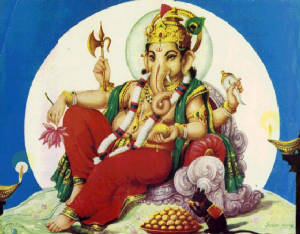Maya : The Big Pot in the Big Picture
Part Two
By Marilynn Lea Stark

It remains difficult to conceptualize how action and time interrelate from examples given which are beyond the ken of the moment-to-moment actions in the daily life and in the surrounding world with which we are so directly familiar. Thus we may take one origination of action as the source for all action in the physical world and learn from it conceptually, but how does that give us the reasoning process to then perceive time in the daily life according to the truth just drawn from the more cosmic, or the absolute picture? That is, for the purpose of answering the inquiry after the source of action, there is the root concept that the first, primordial action would have been the creation of the world. Therefore, this creation would mark the beginning of time. From that beginning of time would be the cause of action; from that gathering up of matter somehow, which is an action, would be found the beginning or cause of time. Yet when we review the transcending of time available to an individual, which is known to come about at final exitus from samsara when moksha is realized for that jiva, the timelessness of the atma is demonstrating how actions draw from time; for in the opportunity to realize the fruits of actions from lifetime to lifetime, from incarnation to incarnation, like stepping stones in a river of seemingly eternal passage, actions can be addressed in a karmic sense, their fruits exhausted, and time conquered insofar as moksha is accomplished. Time and action do interrelate, whether action is drawn from time, or time is born of action. In the manifest world, where there is action, there is time.

karma brahmod bhavam viddhi brahmakshara samudbhavam
tasmat sarvagatam brahma nityam yagne pratishthitam.
This, the fifteenth verse of the Third Discourse of the Bhagavad Gita, translates accordingly:
Know that action has arisen from brahman, and brahman from that which is imperishable;
therefore, the all-pervasive brahman is ever established in sacrifice.
By ‘ever established in sacrifice’ is meant that all actions, when viewed as of the power or cause of Lord Brahman, those actions are through that power born of the timeless nature of brahman. That is why the term Ishvara is used to include the concept of cause, or maya, directly and yet diffusely in the creation, and which distinguishes it from brahaman. Nityam means literally that which is the same in all three periods of time. The key concept in understanding the nature of sacrifice, yagna, is that brahman is the ulterior source of sacrifice, which is action relegated to the shakti, power, of the creation, wherein establishment of brahman in sacrifice makes brahman distinct then again from the changes, the time-bound nature of the exact actions which comprise any sacrifice. Since that is so, then sacrifice is born of action, which means that the significance of any action is not so much physical, as it is spiritual. This points up the importance of understanding how karma “runs things” from a non-causal basis.
However, this argument may be understood, and still the actions in daily life remain bound up in the question of the power and nature of time. Still, the individual running out of the door to begin the day in a panic state, is the same individual considering perhaps even skillfully, the same concepts being discussed here. This yogic science is pursued because of the results it effects in those who integrate its long-established truths in their lives, and by lives is meant daily lives, not karma forthwith. Therefore, the question will be posed by the one who panics under deadlines and narrowly escapes disaster each day in traffic due to the pressure of time, as to the true nature of time. Is that time across which karmic law is written and postulated by actions due to their sacrificial nature, the exact, same and precisely equal time which sweeps into the mind in the morning rush hour? Is that boy bouncing a ball and measuring its activities by accurate prediction, accomplishing his accuracy in the rebound catch, through the same rule of time which mediates in the spiritual journey of the jiva? What is this ‘time’? Can one really befriend time? These are the most vital questions to a metaphysical inquirer, for if answered well and completely, a deeper realization of the Self is born. An evenness of mind and a happiness will be found, and that in the daily life. A greater preparedness for the great challenges of life will be found through such working knowledge of the true meaning of time as it relates to causality, and to actions also in the sense of karma and its laws.

tattvavittu mahabaho guna karma vibhagayoh
guna guneshu vartanta iti matva na sajjate
This is the Twenty-eighth verse of the Third Discourse of the bhagavad gita, which is translated as follows:
But he who is a knower of the truth, Oh mighty-armed one, of the divisions of the gunas and actions,
As such that the gunas remain in the midst (effects) of those gunas, he is not attached (to actions.)
That is a critical verse to parse for its meaning. For by saying that the three gunas remain in the effects of gunas is to say that there is no direct cause between the objects, say, of the senses, as they are affected by the gunas. The gunas are conceptually in the mysterious domain of maya, which is the karana-sharira in the big picture. And the ‘big picture’ here reviews the question of the absolute as it pertains to the relative realm. If those gunas from the unmanifest realm of maya are understood to bring about definite effects in the relative and manifest realm due to the causal nature of maya, and those gunas remain yet in the manifest realm, then the nature of the causality of maya has at least been characterized. How has it been characterized?
The word in Sanskrit is anirvacaniya, or that which by essential nature cannot be categorically ordinated, and therefore cannot be reasoned after by any belonging to a certain group or collective identity. In this example, the cause of maya in her three gunas carries over into the effectual side of the question from the absolute to the relative, in the stead of the gunas subsequently seen as effect in the manifest world, and they remain there. In order to understand the meaning of this residual carry-over of the three gunas from maya as cause to maya as effect, consider an example of a case in the relative realm which should illustrate the opposite situation, and a situation in which the categories are comparable and therefore can accommodate reasoned logic of a direct kind. Imagine a person pushing a cup across the tabletop. The hand imparts the motive force, and is obviously connected to the moving object as a causal force. Unless the surface is largely free of friction, the cup will stop moving when the hand is withdrawn, or when the hand stops the pushing force onto the cup. The hand is the visible cause of the moving cup. The force exerted by the hand upon the cup remains with the cup as the cup moves, and even a child will perceive the causal nature of the event. In the event of moving the same cup across a slippery tabletop which is covered with spilled cooking oil, the hand may let go of the cup, and yet the cup will keep moving for a given, perhaps small distance. So we may perceive by inference in this world a causal carryover in a mechanistic frame of reference, which relegates a cause to an event even when the causal or motive force is not directly attached, visible, or in some cases, even obvious. And we will generally measure that causality in the continuum of time, such as counting the number of seconds it takes to use an electronic gadget to open a garage door instead of leaving the car on foot in order to open it. In the case of maya the gunas remaining attached to the objects of the sense perceptions now in the relative realm, from the dominion of maya in the unmanifest, absolute dominion wherein the three gunas are said to inhere, refutes a direct causal attachment. From the grossest relative, physical, to the more subtle physical yet still relative, to the absolute frame of reference, we must reason : the causality is respectively visually apparent and straightforward, as in the hand moving the cup on a friction-filled table; next the causality seems to be more subtly connected when the cup and hand part ways on the greasy surface, yet the cup keeps moving — it slides, it keeps a momentum past the motive force of the hand as instantaneous cause of its motion; now one would expect in considering causality from the unmanifest and absolute realm of maya to the physical plane, that by all means, the remarkable presence of shakti, the event of God immeasurable, would certainly allow that with the effect no trace of cause would be found. That case would be expected where guna as cause would translate to guna now gone, removed, nowhere to be seen or inferred, since the power of Ishvara so effected upon this world is most probably beyond belief, match, comprehension, measure or extended belief. To say that the three gunas of maya remain in their translation into the relative realm, even if this is by inference, and since it is known as effect, is to simplify causality into a sense wherein it is hardly causal, given the parameters as transitional from absolute to relative. In the gross level of reality we can understand the departing hand from the cup on a greasy surface. As we approach technological conveniences, we envision a type of magic wherein no visible physical connection even exists to our eyes, yet we move objects and change television stations with flick of a button. Now in the ethereal mode of action as relates to metaphysical inquiry after the truth of the nature of action as it regards time, it is as if the hand which never left the cup on the friction-filled tabletop would be the least expected connection of all. Yet the gunas remain, even despite the categorical separateness of the karma and the gunas, in the field of the sense perceptions where these gunas are seen as effect : this remaining hand on the cup is the hand of Ishvara.
This concept should now be ripe for the giving, and that is the concept that guna guneshu vartante constitutes a non-dualistic provision in the reality precept lent the Vedantic thinking through these words from the Bhagavad Gita. For in the matching of the gunas through the majesty of maya from her unmanifest to her manifest form in this world, all action is seen as resting upon knowledge of Ishvara if one knows the truth of these gunas accordingly. By unifying karma from its division from the gunas through the carryover of the gunas from cause to effect, wherein they remain as in effect, the very power of God is made inferentially present in the dualized relative world of opposites. How dualized is that world to the one who can trace across non-comparative categories the nature of action, such as are those non-comparative categories of the absolute to the relative, and vice versa ? By ever invoking the knowledge of the shakti in this creation, Ishvara takes charge in the question of the causality of time, in the question of time as being cause of action right from the primordial vantage point; and what remains is detachment from action. That detachment becomes expressed as sattva. In such a state of awareness of the true nature of the reality of this creation, one becomes endowed with the balance that is sattva, in mind and in deed, or action.
Did you ever happen to think that maya is the upadhi of atma? Consider any upadhi as, “That which throws it attributes upon another thing which is in its proximity,” in the words of Swami Dayananda. upa means ‘near’, and adhi means ‘over’ or ‘above’ or ‘on’; thus upadhi signifies the importance of placement, and of proximity, in the adaptation of attributes, whose adaptation is described as a throwing since the giver of attributes is positioned also above or over its recipient. Thus upadhi constitutes an adjunct entity or presence. Review the description of maya as non-categorical, or anirvacaniya. This means that maya cannot be discerned as belonging to one or the other of these categories: existence/non-existence, or totality/partial. Now consider that as the upadhi of atma, maya fulfills its status in regards to its non-status categorically, as anirvacaniya, since maya connects the jivanmukta as a go-between, or a double agent, to the non-causal brahman. This will puzzle some, whose reasoning will follow from the idea that in all the spheres of thinking that exist, the one sphere where ‘what is’ should be definite and undoubtable, is that of metaphysics. Now in metaphysics there is an explanation for causality which involves a non-categorizing excuse for ‘what is’ from the middle ground not of ‘what is’ versus ‘what is not’ as a platform, but of what neither is nor is not, and as from more of a logically-based fulcrum.
In order to delve further into this topic, let us begin with the concept of equal. If the absolute brahman, which is nirguna, or absent of any attributes, is total, the whole, then it should be equal to the relative world, the creation with its causal nature, maya. Certainly one can say that brahman is equal to the relative, physical world, in the sense that the relative world can never be greater than the totality of brahman. Yet, the srshti, or creation of cause, cannot be equal to the totality of brahman, for srshti becomes the relative world invested of the limits which accompany time and change. Maya stands between these two categories of whole and part of the whole, belonging to neither.
Then if equality does not solve this relation between the absolute and the relative, between brahman and Ishvara, and which equality concerns itself with the logic of identity, then there must be another logic to consider in answer to the puzzle of where fits maya in the big picture of things. The identity cited in the preceding case is of course the identity of oneness, as in mathematics where a theorem may be proved by identity, or any quantity divided by itself is equal to one. Can there be a higher order logic which could house maya ? There is a further mathematical relationship available for use, and that involves the function of variables, how variables depend or do not depend upon one another in a relation. In such consideration as allowed by a relation, there can be a dependent variable and an independent variable. In the case of brahman there is nothing upon which brahman depends whatsoever. The relative world, srshti, depends then again on brahman. There is not equal logic back and forth between the absolute and relative, as between the relative and absolute. In other words, the absolute and relative are not interdependent.
Where does maya stand in this? Maya depends upon, or is a function of, brahman, since it cannot exist without brahman, the changeless totality. Yet it cannot exist with brahman, either. Maya governs over change from an astute vantage, like an absentee landlord who occupies the residence simultaneously, defining maya as more of a double agent than a persona. Maya cannot be traced logically except by inference for its effect, so that cause is once removed and therefore only direct if viewed from the theological haven of the moving hand of Ishvara as the ultimate mover of all, the most real cause of all.
The fundamental problem in reasoning through comparative likenesses between the relative and the absolute, or between brahman and maya as maya relates to the jagat, lies in their profound non-comparative attributes. Maya is like a clearinghouse for categorical clashes metaphysically, which clashes are in the sense of prakrti, or nature, supposed to harmonize perfectly and answer like a melody all of the logical attributes of the manifest world about us. And this is further supposed to place our quest for the love of God, of Self and of destiny, in the safe haven of truth construed so elegantly unto the universal level.
The only mathematical concept which can begin to answer directly these paradoxical quandaries relies upon the transcendence of oneness, of unity, so that maya unifies action and time. Maya as mithya can be used as example to teach the nature of universal truth, or satyam. Satyam may underlie substance, but the form of the pot is necessary to existence made of clay — clay is the satyam of the couplet. Clay needs no form. Further, clay needs no form even though it may occupy space. If a particularly beautiful pot is viewed, the owner will proudly proclaim that the beauty of the pot is born of the superior kind of clay which had been refined and used for its creation. In that case the attributes of the clay tell the story of how satyam is typically mistaken for mithya in everyday life. Beauty is an attribute of God, and where an unrivaled pot presents for scrutiny in its beauty, instead of praising form and color, the admirer gets carried away in the argument for this unique quality in the renowned pot and declares it to be made of an unmatched substance, a rare clay that nobody else is ever likely to even find. Therefore, no matter how superior the pot maker or sculptor, or artist for painting the beautiful pot, without the greater quality clay the match will never be made. Reality is hard-won when it is so far removed from likelihood, from access in the competition. Mithya is subordinate to satyam as we have seen, since it depends upon satyam. Ordinary pots can compete with those of the rarer quality clays only if beauty is in the eye of the beholder as an old adage says. Yet there will always be that one knower who arrives and proves that material in the skilled hands of one who sees beyond sheer matter can overcome a false claim of superior clay as reason for a superior pot. This truth of satyam/mithya is what clarifies the mind for the acute perceptive abilities which are native to the individual who excels, prospers and by example leads others through that truth. Thus although cause is a captivating inquiry in the world of physical matter and moving objects and how we as individuals relate to that world, to discern the reality of transcendental oneness as in and through everything and every jivanmukta, as present in the story of the pot and clay dichotomy, of satyam and mithya, is an answer indeed to be sought after tirelessly.
Written by Marilynn Stark January 2, 2002

